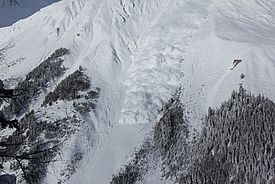18.01.2016 | News
An international research team of the WSL Institute for Snow and Avalanche Research SLF today successfully carried out a large-scale experiment at the SLF's Vallée de la Sionne avalanche test site (Cmne d'Arbaz, Valais), which is without parallel worldwide. The researchers are using the collected data to assess how large-sized avalanches move, what forces they generate, and the best way to protect communities, transportation routes and infrastructure.
For the experiment, explosives fired from helicopters triggered a large powder avalanches which travelled a distance of around 2.5 km down to the valley floor. The avalanche reached a speed of 200 km/h. Among the other resources used by the researchers were laser scanners, thermal imaging cameras, photogrammetry and radar measurements (see also the Valléé de la Sionne project page).
It was the interaction of numerous factors that allowed the experiment to succeed – snow quantity, weather situation, good visibility for the helicopter flight and measuring instruments, and an unstable snowpack, but not to such an extent that natural avalanches were triggered prematurely. The research team were therefore delighted with the successful outcome.
"In this experiment we took measurements by means of new infrared temperature sensors and new pressure sensors. Among other indicators, they measure the temperature prevailing in different zones of the avalanche, which in turn determines the distance the avalanche travels. And the radar situated in the bunker was able to capture images of the avalanche with a much improved resolution," says Betty Sovilla, the scientific director of the trial. "I am very much looking forward to seeing the new data."
Copyright
WSL and SLF provide the artwork for imaging of press articles relating to this media release for free. Transferring and saving the images in image databases and saving of images by third parties is not allowed.
